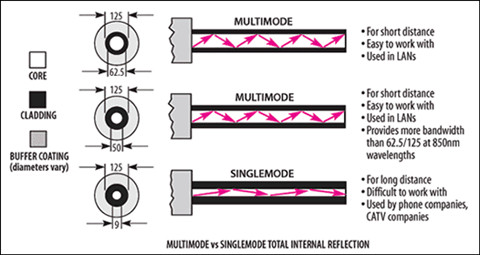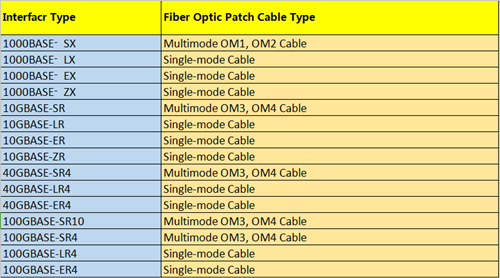Fiber optic patch cable as the basic element of a network, transmits signals through strands of glass or plastic fiber. Fiber optic cables are available in multimode and single-mode fibers terminated with LC, SC, ST, LC, FC, MTRJ, E2000 connectors in simplex and duplex. The typical multimode fiber used in telecom or datacom applications has a core size of 50 or 62.5 microns. Single-mode fiber shrinks the core size down to 9 microns so that the light can only travel in one ray. Different fiber types like multimode or single-mode fibers connect with fiber optic transceivers resulting in different performances, which makes a huge impact on the network application. Here is what you need to know about the fiber types and the corresponding optical transceivers for network infrastructure.
Internal Structure of Single-mode and Multimode Fiber Optic Cable
An optical fiber is a flexible filament of very clear glass capable of carrying information in the form of light. Single-mode fiber optic cable has a small diametral core of 9/125 microns that allows only one mode of light to propagate, which results in light reflections, lower attenuation and creating the ability for the signal to travel faster, further. That’s why single-mode fibers are typically used in long-reach applications.

MM fiber patch cords, however, has a large diametral core of 50/125 and 62.5/125 in construction that allows multiple modes of light to propagate. Therefore, the number of light reflections created as the light passes through the core increases, creating the ability for more data to pass through at a given time. Because of the high dispersion and attenuation rate with this type of fiber, the quality of the signal is reduced over long distances. The above picture shows the inner structure of fiber optic cables.
Factors When Choosing Single-mode or Multimode Fiber
Different core diameters of single-mode and multimode fiber optic cables affect the optical properties and have a direct impact on system performance. Besides this, other factors like bandwidth, attenuation and costs also have the biggest impact on the system performance. Figure 2 gives you a vivid description of single-mode and multimode fiber.

Attenuation is the reduction of signal power, or loss, as light travels through an optical fiber. Fiber attenuation is measured in decibels per kilometer (dB/km). The higher the attenuation, the higher rate of signal loss of a given fiber length. Single-mode fibers generally operate at 1310 nm (for short range) while multimode fibers operate at 850 nm or 1300 nm. Attenuation is not usually considered to be the main limiting factor in short rang transmissions. But it can cause big differences in high speed network such as 100Gb/s.
Bandwidth means the carrying capacity of fiber. For single-mode fiber, the modal dispersion can be ignored since its small core diameter. Bandwidth behavior of multimode fibers is caused by multi-modal dispersion during the light traveling along different paths in the core of the fiber. It has an influence on the system performance and data rate handling. Multimode fiber uses a graded index profile to minimize modal dispersion. This design maximizes bandwidth while maintaining larger core diameters for simplified assembly, connectivity and low cost. So manufacturers start to develop higher-performance multimode fiber systems with higher bandwidth.
Costs: A fiber optic transceiver usually consists the optical light sources, typically LED–light emitting diode and optical receivers. Since the core diameter size and primary operating wavelengths of single-mode fiber and multimode fiber are different, the associated transceiver technology and connectivity will also be different. So is the system cost.
To utilize the single-mode fibers generally for long distance applications, transceivers with lasers that operate at longer wavelengths with smaller spot-size and narrower spectral width. But these kinds of transceivers need higher precision alignment and tighter connector tolerance to smaller core diameters. Thus, it causes higher costs for single-mode fiber interconnections. To lower the cost, manufacturers produce transceivers based on VCSEL (vertical cavity surface emitting laser), for example, 10G-SFPP-SR is a SFP+ transceiver support a link length of 300m, which are optimized for use with multimode fibers. Transceivers applying low cost VCSEL technology to develop for 50/125μm multimode fibers, take advantage of the larger core diameter to gain high coupling efficiency and wider geometrical tolerances. OM3 and OM4 multimode fibers offer high bandwidth to support data rates from 10Mb/s to 100Gb/s.
Fiber Type and Associated Optical Transceiver Compatibility Matrix
From a technician's standpoint, optical transceivers should be compatible with fiber optic cables, meaning that multimode transceivers should only connect with multimode fiber optic cables, or you may end up with an error. Table 3 summarizes various optical interfaces and their performance over the different fiber types. The table specifies the maximum reach achievable over each fiber type and the requirement for a mode conditioning patch cord.

This table is directly derived from the IEEE 802.3-2005 standard, if you comply with the standard, these performances are guaranteed and longer reaches may be achievable depending on the quality of each link. To ensure whether a link can work, all you can do is to try and see if the performance is satisfactory. The link should be either error-free for critical applications, or the bit error should remain below 10-12 as per minimum standard requirement. For instance, it may be possible to reach much longer distances than 550 m with an OM3 laser-optimized fiber and 1000BASE-SX interfaces. Also, it may be possible to reach 2 km between two 1000BASE-LX devices over any fiber type with mode conditioning path cords properly installed at both ends. Single mode fiber patch cables as noted before, are suitable for long-haul application. Although the optics are more expensive, they’re offering much longer reach, which makes them an ideal choice for network infrastructure.
Conclusion
Choosing the right fiber for your network application is a critical decision. Whether to use single-mode or multimode fiber for your infrastructure, no one can give your the best answer. Only by fully understand the system requirements and select the appropriate fiber can you maximize the value and performance of your cabling system. FS.COM offers cost-effective fiber optic patch cables to meet the requirements of all the customers. If you are interested, please send your request to us.

Thank you for the information Fiber optic network cabling
ReplyDeleteThank you for the information structured cabling service
ReplyDelete